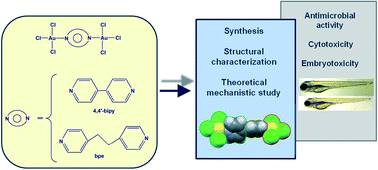Synthesis, structural characterization and biological evaluation of dinuclear gold(iii) complexes with aromatic nitrogen-containing ligands: antimicrobial activity in relation to the complex nuclearity†‡
Abstract
Dinuclear gold(III) complexes {[AuCl3]2(μ-4,4′-bipy)} (1) and {[AuCl3]2(μ-bpe)} (2) with bridging aromatic nitrogen-containing heterocyclic ligands, 4,4′-bipyridine (4,4′-bipy) and 1,2-bis(4-pyridyl)ethane (bpe), were synthesized and characterized by NMR (1H and 13C), UV-vis and IR spectroscopic techniques. The crystal structure of 1 was determined by single-crystal X-ray diffraction analysis, while the DFT M06-2X method was applied in order to optimize the structures of 1 and 2. A detailed mechanistic study was performed using the same DFT approach in order to shed light on the disparate coordination modes of the presently investigated N-heterocyclic ligands and the monocyclic pyrazine, which contains two nitrogen atoms within one ring, toward the AuCl3 fragment. The investigation of the solution stability of 1 and 2 in DMSO revealed that both complexes were sufficiently stable in this solvent at room temperature. Complexes 1 and 2, along with K[AuCl4] and the N-heterocyclic ligands used for their synthesis, were evaluated by in vitro antimicrobial studies against a panel of Gram-positive and Gram-negative bacteria and the fungus Candida albicans. In most cases, complexes 1 and 2 have higher antibacterial activity than K[AuCl4] (MICs for 1 and 2 were in the range 3.9–62.5 μg mL−1), while both of the N-heterocycles did not affect the bacterial growth at concentrations up to 500 μg mL−1. On the other hand, the antifungal activity of these two complexes against C. albicans was moderate and lower than that of K[AuCl4]. In order to determine the therapeutic potential of 1 and 2, their antiproliferative effect on the normal human lung fibroblast cell line MRC5 and embryotoxicity on zebrafish (Danio rerio) have also been evaluated. To the best of our knowledge, complexes 1 and 2 are the first examples of dinuclear gold(III) complexes with aromatic six-membered heterocycles containing two nitrogen atoms as bridging ligands.


 Please wait while we load your content...
Please wait while we load your content...